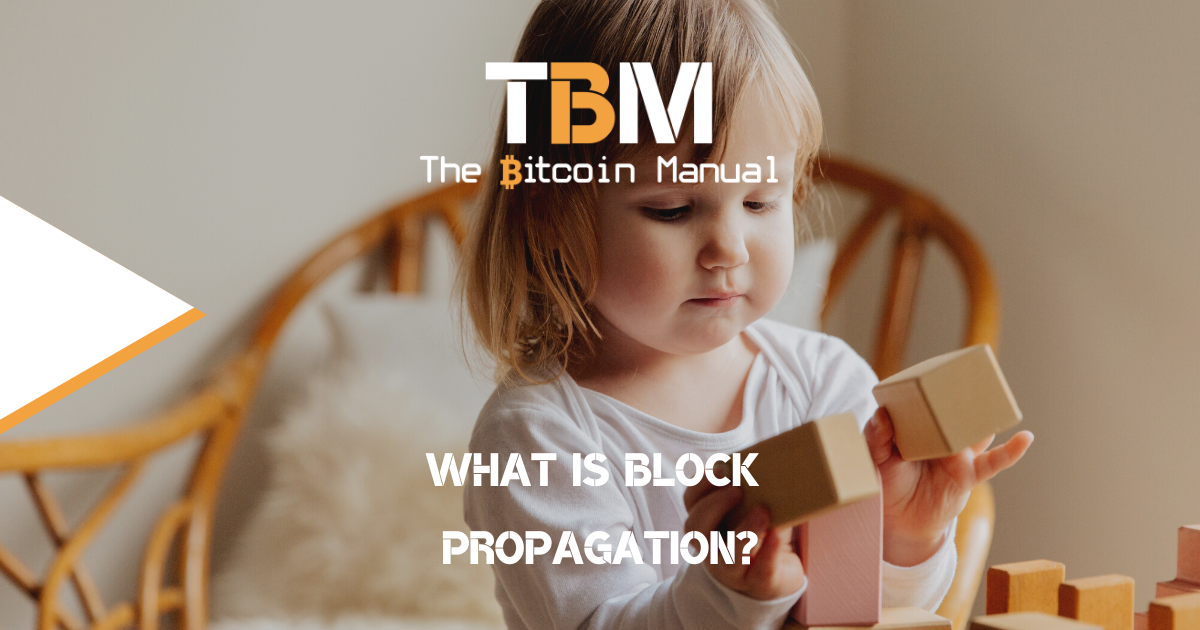Bitcoin is a blockchain-based network comprised of thousands of nodes distributed worldwide that remain connected and communicate through a gossip-based flooding protocol. When a block is successfully mined, that mined block is propagated to all participating nodes in the network and added to the chain.
All nodes must remain synchronised with the latest transactions so that the process can be repeated and a new block can be added.
What is block propagation?
Bitcoin block propagation is the process of disseminating newly mined blocks to all nodes on the Bitcoin network. This is done through a peer-to-peer (P2P) gossip protocol, where each node broadcasts new blocks to its peers. Once a node receives a new block, it validates it and then broadcasts it to its own peers. This process continues until all nodes on the network have received the new block.
The median time until a node receives a block is 6.5 seconds, whereas the mean is around 12.6 seconds. The long tail of the distribution means that even after 40 seconds, all nodes have not validated the latest block.
Here is a simplified overview of how Bitcoin block propagation works:
- A miner mines a new block and adds it to their local blockchain.
- The miner broadcasts the new block to their peers.
- Each node that receives the new block validates it.
- If the block is valid, the node adds it to its local blockchain and broadcasts it to its own peers.
- This process continues until all nodes on the network have received the new block.
In a large decentralised network like Bitcoin, whenever a new block is generated, it is broadcasted according to the Gossip protocol and communication of the update has its limitations, so you cannot simply speed up this process without trade-offs.
Block propagation is an important part of the Bitcoin network because it ensures that all nodes have a consistent view of the blockchain. This is necessary for the network to reach a consensus on which blocks are valid and which transactions have been confirmed.
Bitcoin block propagation is typically very fast, with new blocks being propagated to the entire network within a few seconds. However, there can be some delays depending on the network conditions and the number of nodes on the network.
Some of the factors that can affect Bitcoin block propagation speed:
- The number of nodes on the network
- The network bandwidth of the nodes
- The size of the block
- The network latency
Bitcoin block propagation is an integral part of the Bitcoin network, and it is one of the things that makes the network so secure and reliable.
Why is block propagation important?
Block propagation is critical for maintaining the integrity and consistency of the blockchain across all participating nodes. The issue with this process is the time it takes to transmit these blocks, especially as they increase in size and as the network becomes more decentralised with more nodes online.
To ensure audibility and verifiability, blocks are transmitted in their entirety, which can lead to slow block transmission times. A long propagation delay is also stated to reduce the node’s resistance against 51% attacks and selfish mining.
These are attributes Bitcoin cannot sacrifice as they are part of the value proposition. Bitcoin’s current limitations on block propagation are the rational trade-off so that the security and reliability of the network do not suffer.
Whenever people talk about the scalability of the blockchain, they often focus on the transaction throughput of the system; you’ll hear debates on how many transactions can be settled per minute or day based on current restrictions and how increasing block sizes or making blocks faster would improve the situation.
However, these critics, who are often alt-coiners who don’t have an appreciation for trade-offs, don’t see how throughput increases should not compromise the network’s security or raise data storage requirements for nodes desiring to participate in the network.
Improvements to block propagation
While Bitcoin does have some constraints due to its network size and transaction finality, that doesn’t mean it cannot be improved. Certain solutions have been proposed to improve block propagation time.
Invertible Bloom Lookup Table (IBLT)
One method involves using an Invertible Bloom Lookup Table (IBLT). An IBLT allows set reconciliation, which is useful for Bitcoin block propagation if mempools don’t differ much. With this method, each transaction in a block is sliced into fixed-size slices. Each slice is run through hash functions to get an index into the slice.
Adding a slice will bitwise XOR into the IBLT, and the IBLT doesn’t grow when you add data to it. This IBLT is then sent off to the peer, who makes a guess about which transactions were included. They remove their guesses from the IBLT, leaving only the difference between the block and the recipient’s guess.
Compact blocks for faster relay
Another proposed solution is Gregory Maxwell’s suggestion of compact blocks, which turned into a Bitcoin improvement proposal – BIP 0152 by Matt Corallo. Compact blocks or fast relay protocol reduces the amount of data that needs to be spent by avoiding the transmission of transactions that have already been received by nodes.
These solutions aim to mitigate the problem of slow block propagation times, make the process more efficient, and thus enable smooth operation of the blockchain network.
Do your own research.
If you want to learn more about block propagation, use this article as a jumping-off point and don’t trust what we say as the final say. Take the time to research, check out their official resources below or review other articles and videos tackling the topic.




